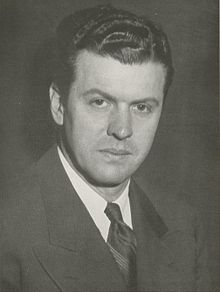Wes Fesler

Fesler from The Owl, 1947
|
|
| Sport(s) | Football, basketball, baseball |
|---|---|
| Biographical details | |
| Born |
June 29, 1908 Youngstown, Ohio |
| Died | July 30, 1989 (aged 81) Laguna Hills, California |
| Playing career | |
| Football | |
| 1928–1930 | Ohio State |
| Position(s) |
End (football) Guard (basketball) |
| Coaching career (HC unless noted) | |
| Football | |
| 1931–1932 | Ohio State (assistant) |
| 1933–1940 | Harvard (assistant) |
| 1941–1942 | Wesleyan |
| 1945 | Princeton (assistant) |
| 1946 | Pittsburgh |
| 1947–1950 | Ohio State |
| 1951–1953 | Minnesota |
| Basketball | |
| 1933–1941 | Harvard |
| 1945–1946 | Princeton |
| Head coaching record | |
| Overall | 41–40–8 (football) 67–108 (basketball) |
| Bowls | 1–0 |
| Accomplishments and honors | |
| Championships | |
| 1 Big Ten (1949) | |
| Awards | |
|
All-American, 1928 All-American, 1929 All-American, 1930 |
|
|
College Football Hall of Fame Inducted in 1954 (profile) |
|
Wesley Eugene "Wes" Fesler (June 29, 1908 – July 30, 1989) was an American football, basketball, and baseball player and coach of football and basketball. He was a three-sport athlete at Ohio State University and a consensus first-team selection to the College Football All-America Team three straight years (1928–1930). Fesler was later the head football coach at Wesleyan University (1941–1942), the University of Pittsburgh (1946), Ohio State (1947–1950), and the University of Minnesota (1951–1953), compiling a career record of 41–40–8. He was also the head basketball coach at Harvard University (1933–1941) and Princeton University (1945–1946), tallying a mark of 67–108. Fesler was inducted into the College Football Hall of Fame as a player in 1954.
Fesler came to Ohio State from Youngstown, Ohio. At Ohio State, Fesler was a member of both Pi Kappa Alpha and Phi Beta Kappa, earning a total of nine varsity letters in baseball, basketball, and football. He was a charter inductee in the Ohio State Varsity O Hall of Fame in 1977.
Many believe Fesler's greatest talents were in football. He primarily played end and was a consensus first-team All-America selection in 1928 and 1929 and a unanimous first-team All-America selection in 1930. Depending on the game situation, he would sometimes move into the backfield as a fullback. In 1930, he was voted the Most Valuable Player in the Big Ten.
...
Wikipedia
